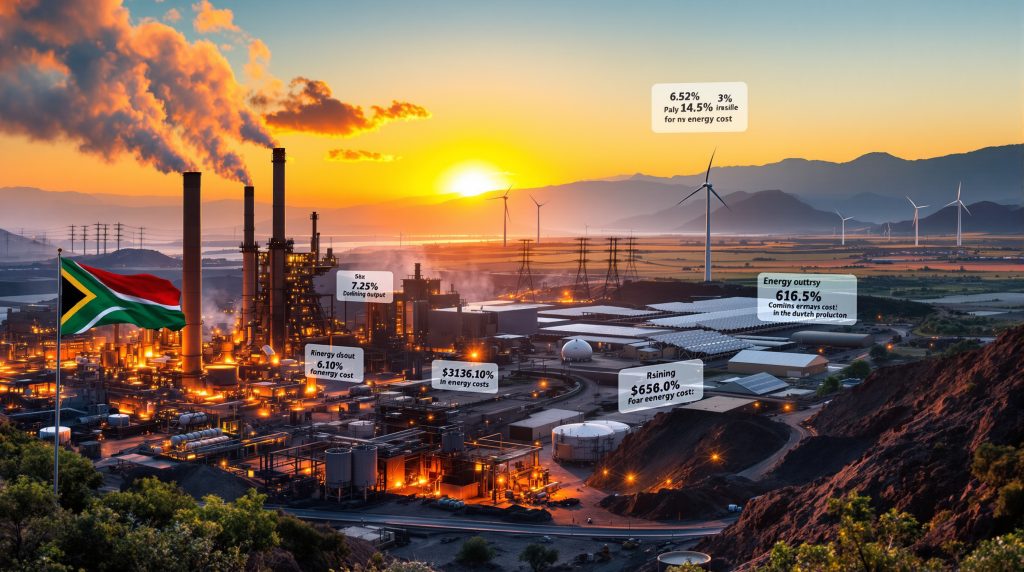How Is South Africa's Energy Crisis Affecting Its Industrial Competitiveness?
South Africa's once-dominant industrial sector faces significant challenges due to persistent energy instability. The country's manufacturing prowess, particularly in energy-intensive sectors, has eroded substantially over the past two decades, transforming a former global leader into an increasingly marginalized player in international markets.
The manufacturing sector's contribution to GDP has fallen dramatically from 21% in the 1990s to just 12.1% in 2023, according to Statistics South Africa. This decline coincides with escalating electricity challenges that have severely constrained industrial operations across the country.
The Economic Impact of Energy Instability
During periods of severe load shedding, industrial output typically declines by approximately 20%, with energy-intensive sectors bearing the heaviest burden. The Steel and Engineering Industries Federation of Southern Africa reports that the metals and engineering sector alone has shed approximately 80,000 jobs over the past decade, largely attributed to unreliable and expensive electricity.
The South African Reserve Bank has quantified this impact, estimating that electricity constraints have reduced annual GDP growth by 2-2.5 percentage points during peak load shedding periods. Between 2007-2022, load shedding cost the South African economy an estimated R899 billion, according to the Council for Scientific and Industrial Research.
For ferroalloy producers, the situation has been particularly dire. Electricity costs now represent 30-40% of total production expenses, with tariffs increasing by approximately 450% since 2007. This dramatic rise has rendered many operations economically unviable against international competition.
Industry impact: The South African Capital Equipment Export Council reports that ferroalloy production capacity utilization fell to below 40% in 2023, compared to over 80% in 2010.
What Role Can Coal Play in South Africa's Energy Transition?
Despite global pressure to reduce carbon emissions, coal remains the backbone of South Africa's electricity generation, accounting for 79% of production in 2023. This dominance reflects both the country's abundant coal reserves and the established infrastructure built around this resource over decades.
The coal mining sector remains a significant employer, providing approximately 91,000 direct jobs in 2023, according to the Minerals Council South Africa. Many of these jobs are concentrated in regions with few alternative employment opportunities, particularly Mpumalanga province.
Coal's Current Position in South Africa's Energy Mix
South Africa faces a complex dilemma in balancing immediate energy security needs with longer-term environmental commitments. While the country has signed onto international climate agreements, the practical reality of its energy infrastructure makes immediate coal phaseout impractical.
The Department of Mineral Resources and Energy notes that coal provides the baseload power essential for industrial operations, offering reliability that current renewable alternatives cannot yet match at scale. This reliability is particularly critical for energy-intensive sectors like ferroalloys, which require consistent high-voltage electricity.
- Coal currently powers approximately 38,000 MW of Eskom's 45,000 MW generation capacity
- The sector contributes significantly to local economies in Mpumalanga, Limpopo, and KwaZulu-Natal
- Coal remains the most cost-effective immediate solution for addressing electricity shortages
- Coal royalties and taxes provide substantial revenue for government services
Balancing Coal Use with Environmental Commitments
The International Energy Agency's Africa Energy Outlook recognizes that "coal will remain important for South Africa's energy security in the near to medium term" while the country develops alternative capacity. This pragmatic view acknowledges the reality of South Africa's energy infrastructure.
South Africa has secured $8.5 billion in climate finance commitments from international partners through the Just Energy Transition Partnership, announced at COP26. However, implementing this transition requires careful planning to avoid exacerbating current coal supply challenges.
Eskom's newer coal stations (Medupi, Kusile) employ supercritical technology with efficiency rates of approximately 38-40%, compared to 30-32% for older stations. These improved efficiencies represent a significant emissions reduction per unit of electricity generated.
The average age of Eskom's coal fleet is 39 years, with several stations exceeding 50 years of operation. Camden (1,600 MW), Hendrina (1,965 MW), and Grootvlei (1,200 MW) are scheduled for decommissioning between 2025-2030, creating urgency around replacement capacity.
How Can South Africa Reclaim Its Position in Ferroalloys Production?
South Africa's decline in the global ferroalloys market represents one of the most dramatic industrial retreats of recent decades. From a position of market dominance, the country has seen its share of global ferrochrome production decline from 50% in 2000 to approximately 33% in 2023, according to the International Chromium Development Association.
The erosion in ferromanganese has been even more severe, with production capacity falling from approximately 600,000 tonnes per year in 2010 to under 250,000 tonnes in 2023. This collapse occurred despite South Africa holding approximately 75% of the world's identified manganese resources.
The Decline of South Africa's Ferroalloys Industry
The past decade has witnessed a series of high-profile smelter closures across South Africa:
- Metalloys (Meyerton) – closed 2020
- Mogale Alloys – closed 2016
- Assmang Cato Ridge – closed 2015
These closures reflect the industry's inability to compete internationally in the face of escalating electricity costs and unreliable supply. Research by the Industrial Development Corporation found that South African ferroalloy producers faced electricity costs 40-60% higher than competitors in China and India by 2022.
Strategic Pathways to Revival
Revitalizing South Africa's ferroalloys industry requires a comprehensive approach addressing several interconnected challenges:
-
Electricity pricing models: Developing specialized tariffs for energy-intensive industries that reflect their economic importance and provide long-term certainty
-
Supply reliability: Ensuring consistent electricity supply through dedicated generation capacity and transmission infrastructure
-
Operational efficiency: Modernizing production facilities to improve energy efficiency and reduce costs
-
Value chain integration: Strengthening links between mining operations and processing facilities to capture more value domestically
The Minerals Council South Africa emphasizes that restoration of idle smelter capacity could create thousands of direct and indirect jobs while boosting export earnings. This revival would leverage South Africa's existing mineral resource advantage to rebuild industrial capacity.
What Makes the Khwelamet Acquisition Significant for South Africa's Industrial Future?
The acquisition of the Meyerton-based Khwelamet complex (formerly Metalloys) by Menar and Ntiso Holdings represents a potential turning point for South Africa's ferroalloys sector. This facility, once fully operational, could play a transformative role in reclaiming South Africa's position in global ferromanganese markets.
According to industry sources, the Khwelamet complex has installed capacity of approximately 350,000 tonnes per annum of ferromanganese production. This represents significant production potential in a global market estimated at 10.5 million tonnes in 2023.
Strategic Importance of the Khwelamet Complex
The significance of this acquisition extends beyond the immediate economic impact to encompass broader strategic considerations:
- Vertical integration potential: South Africa's abundant manganese reserves (75% of global resources) provide a natural competitive advantage for domestic processing
- Export earnings: Ferromanganese commands significantly higher prices than raw manganese ore, enhancing foreign exchange earnings
- Industrial ecosystem: A revitalized smelter creates demand for inputs like reductants, refractories, and specialized services
- Technical capabilities: Preserves and develops specialized metallurgical skills essential for industrial development
The Meyerton location offers significant advantages, including proximity to Gauteng's industrial hub, access to rail infrastructure via Transnet, and relative proximity to major manganese ore sources in the Northern Cape.
Critical Success Factors for Khwelamet's Revival
Menar's Chief Commercial Officer, Ruan Nothnagel, speaking at the Joburg Indaba conference, emphasized that the revival is "largely dependent on securing affordable electricity." This highlights the central challenge facing energy-intensive industries in South Africa.
For the Khwelamet complex to succeed, several critical factors must align:
- Affordable electricity: Long-term power purchase agreements at internationally competitive rates
- Supply reliability: Consistent electricity supply without load shedding interruptions
- Technical expertise: Rebuilding the specialized workforce needed for ferroalloy production
- Market access: Securing offtake agreements with steel producers domestically and internationally
The revival of this complex could serve as a model for other shuttered industrial facilities across South Africa, demonstrating the viability of reclaiming lost industrial capacity with the right enabling conditions.
How Are Geopolitical Shifts Affecting South Africa's Position in Global Value Chains?
South Africa occupies a unique position in global mineral supply chains, controlling critical resources that are increasingly strategic in an era of great power competition and energy transition technologies. The country holds approximately 75% of global manganese reserves, 70% of chrome resources, and dominates platinum group metals with 90% of global platinum reserves.
This mineral endowment provides potential leverage in international relations, particularly as competition intensifies between major powers for access to critical minerals transition. China accounted for approximately 28% of South Africa's merchandise exports in 2023, making it the largest single export destination.
South Africa's Strategic Resource Position
The US, EU, and China have all classified manganese, chromium, and platinum group metals as critical minerals due to their economic importance and supply concentration risks. This classification elevates South Africa's strategic importance in global supply chains.
The US Inflation Reduction Act includes provisions for critical mineral supply chain diversification, potentially creating new opportunities for South African suppliers that can meet environmental and processing requirements. Similarly, the EU's Critical Raw Materials Act seeks to reduce dependency on single sources of supply.
Menar MD Vuslat Bayoglu noted at the Joburg Indaba that "South Africa should not lose sight of its true worth within global value chains," emphasizing that China, the US, and Europe "benefit immensely from the country's mineral supplies."
Navigating Great Power Competition
South Africa faces both opportunities and challenges in leveraging its mineral wealth amid intensifying great power competition:
-
Balanced engagement: Maintaining productive relationships with China, the US, and European partners without becoming overly dependent on any single market
-
Value capture: Moving beyond raw material exports to capture more value through processing and manufacturing
-
Strategic partnerships: Developing relationships that include technology transfer, skills development, and market access
-
Resource nationalism: Balancing legitimate national interests with maintaining an attractive investment environment
For South Africa to maximize benefits from its resource position, it must develop clear policies on resource beneficiation, export controls, and investment conditions that serve long-term national development goals.
What Is the Relationship Between Energy Security and Reindustrialization?
The connection between reliable, affordable electricity and industrial development is both direct and profound. South Africa's experience demonstrates that energy constraints can reverse decades of industrial progress, while energy security can serve as a foundation for renewed growth.
The South African Reserve Bank's research indicates that for every 1 GW of additional reliable electricity capacity, GDP growth could increase by approximately 0.3-0.5 percentage points annually. This relationship becomes particularly significant when considering South Africa's current growth challenges.
Energy as a Catalyst for Industrial Development
Load shedding has severely constrained South Africa's industrial potential, with the country experiencing 6,947 hours of power cuts in 2023. The achievement of consecutive months without load shedding from March through September 2025 represents a significant improvement, but maintaining this stability is crucial for industrial revival.
Private sector electricity generation registered with NERSA grew from 500 MW in 2020 to over 5,000 MW by the end of 2024, indicating growing business response to energy challenges. However, this self-generation typically comes at higher costs than centralized supply would provide under optimal conditions.
For energy-intensive industries, electricity pricing has become increasingly prohibitive. Average industrial electricity tariffs in South Africa increased to approximately R1.40/kWh in 2024, compared to R0.18/kWh in 2007, representing a nearly 700% increase that far outpaces general inflation.
Case Studies of Energy-Driven Industrial Revival
Several countries provide instructive examples of how reliable energy underpins industrial competitiveness:
-
Malaysia: Maintained electricity reliability above 99.9% while expanding manufacturing, attracting energy-intensive industries including electronics and chemicals
-
Vietnam: Prioritized power sector development alongside industrial policy, growing manufacturing from 12% to 25% of GDP between 2000-2020
-
Industrial parks with dedicated power: Special Economic Zones with reliable electricity provision have consistently outperformed areas dependent on national grids in attracting investment
The common factor across successful cases is the prioritization of electricity reliability and cost competitiveness as fundamental prerequisites for industrial development.
How Can South Africa Avoid Energy Transition Pitfalls?
As South Africa navigates its energy transition, valuable lessons can be drawn from international experiences that highlight both opportunities and potential pitfalls. Several developed economies have encountered significant challenges in their energy transitions that offer cautionary tales for South Africa.
Germany's experience demonstrates the risks of prematurely phasing out baseload capacity. Following its accelerated nuclear shutdown after the Fukushima disaster and concurrent coal phase-out efforts, Germany faced energy security challenges and price spikes. German wholesale electricity prices increased by approximately 250% between 2020-2022, undermining industrial competitiveness.
Lessons from International Energy Transitions
The UK provides another instructive case, where rapid decarbonization contributed to rising energy costs that affected industrial competitiveness. By 2023, UK industrial electricity prices became the second-highest in Europe at approximately €0.27/kWh, contributing to deindustrialization trends.
By contrast, China has pursued a more balanced approach, rapidly expanding renewable energy while maintaining coal generation at 56% of its electricity mix in 2023. This strategy has supported continued industrial growth while gradually reducing the carbon intensity of the economy.
Australia has similarly maintained coal generation at approximately 50% of its electricity mix through 2023 while expanding renewables, prioritizing grid stability and affordability for its energy-intensive mining and manufacturing sectors.
Developing a South African Energy Transition Model
Speaking at the Joburg Indaba, Menar's Vuslat Bayoglu urged South Africa to avoid similar pitfalls to those experienced in European countries, stating: "The country must be very realistic and consider investing in new coal or nuclear capacity."
A pragmatic South African approach might include:
-
Realistic timeframes: Aligning carbon reduction goals with infrastructure development capabilities and economic realities
-
Balanced energy mix: Maintaining sufficient dispatchable generation capacity to ensure system stability
-
Technological neutrality: Evaluating all low-carbon options including nuclear, gas, and clean coal technologies
-
Industrial protection: Creating mechanisms to shield energy-intensive industries from transition costs that would undermine competitiveness
-
Skills development: Building the technical capabilities needed for new energy technologies while preserving expertise in conventional generation
The International Energy Agency recommends that developing economies maintain flexibility in energy transition timelines based on economic development needs and infrastructure readiness.
What Role Should Private Sector Play in South Africa's Energy Future?
The transformation of South Africa's energy landscape increasingly depends on private sector participation, following models established in other infrastructure sectors. The historical monopoly model has proven insufficient to meet the country's growing energy needs and economic development goals.
Private sector renewable energy projects added approximately 4,200 MW of capacity between 2022-2024 through various procurement programs and self-generation. The Renewable Energy Independent Power Producer Procurement Programme (REIPPPP) has attracted over R200 billion in private investment across 112 projects since 2011.
Private Sector Energy Investment Opportunities
Several pathways exist for expanded private sector participation in South Africa's energy sector:
-
Independent power producers: Continuing and expanding procurement programs across multiple technologies including renewables, gas, and potentially coal or nuclear
-
Self-generation: Further streamlining regulations for industrial and commercial entities to generate their own power
-
Transmission infrastructure: Developing new models for private investment in grid expansion and modernization
-
Energy services: Creating opportunities for specialized service providers in energy efficiency, storage, and system optimization
Regulatory amendments in 2022 removed the licensing requirement for private generation projects under 100 MW, significantly expanding self-generation opportunities. This reform has accelerated private investment in energy solutions, particularly in the mining industry evolution.
Successful Models for Public-Private Collaboration
As Bayoglu noted at the Joburg Indaba, "If Eskom's balance sheet cannot support [new capacity] investments, it should allow a partnership with the private sector, like Transnet has done." This reference to Transnet's private participation in rail infrastructure points to potential models for the energy sector.
Other successful examples include:
-
Municipal partnerships: Cities like Cape Town and Johannesburg developing independent power procurement programs
-
Special Economic Zones: Industrial parks with dedicated energy solutions developed through public-private partnerships
-
Mining sector integration: Mining companies developing energy solutions that serve both their operations and surrounding communities
These models demonstrate the potential for innovative arrangements that leverage private sector capital and expertise while serving broader public interest goals in energy provision.
How Can South Africa Maximize Value from Its Mineral Resources?
South Africa has historically exported much of its mineral wealth as raw or minimally processed materials, capturing only a fraction of the potential value. The ferroalloys sector represents a clear example of how downstream processing can multiply the economic value of mineral resources.
While the country exports millions of tons of manganese and chrome ore annually, processing these materials domestically into ferroalloys could increase their value by 3-5 times. Further value addition through specialty steel production could multiply this value again.
Moving Up the Value Chain
Several strategic opportunities exist for South Africa to capture more value from its mineral resources:
-
Ferroalloy revival: Reestablishing manganese and chrome processing capacity to supply global steel markets
-
Battery materials: Developing processing facilities for manganese battery precursors and cathode active materials
-
Platinum beneficiation: Expanding production of catalysts, fuel cells, and other advanced applications of platinum group metals
-
Renewable energy components: Manufacturing inputs for solar panels, wind turbines, and energy storage systems
The US Geological Survey notes that South Africa holds 75% of global manganese reserves (5.2 billion tonnes), creating a natural competitive advantage in processing these materials. Similarly, the country's dominance in chrome and platinum group metals provides opportunities for expanded value addition.
Policy Frameworks to Support Value Addition
Successful value addition requires coordinated policy frameworks that address several interconnected challenges:
-
Energy solutions: Developing reliable and competitively priced electricity for processing operations
-
Skills development: Building the technical capabilities needed for advanced manufacturing
-
Infrastructure: Ensuring transportation, water, and digital infrastructure supports industrial growth
-
Investment incentives: Creating attractive conditions for capital-intensive processing facilities
-
Market access: Negotiating favorable terms in trade agreements for processed materials
The Department of Trade, Industry and Competition's Industrial Development Policy emphasizes the importance of mineral beneficiation in SA as a key pillar of South Africa's reindustrialization strategy. Implementing this vision requires addressing the structural constraints that have limited progress in the past.
What Is the Path Forward for South Africa's Energy Value Chain?
Reclaiming South Africa's energy value chain requires a comprehensive approach that addresses immediate challenges while building foundations for future competitiveness. The path forward must balance pragmatism with ambition, recognizing both constraints and opportunities.
The recent achievement of consecutive months without load shedding from March through September 2025 represents a significant milestone, but maintaining and building on this progress is essential for industrial revival.
Short-Term Priorities (1-2 Years)
Immediate actions should focus on stabilizing the existing electricity system while creating conditions for industrial revival:
-
Maintenance optimization: Continuing to improve the performance of the existing coal fleet through enhanced maintenance programs
-
Private generation acceleration: Further streamlining regulatory processes for independent power producers and self-generation
-
Industrial electricity pricing: Developing specialized tariff structures for energy-intensive industries with potential for job creation and export earnings
-
Idle capacity restoration: Supporting the restart of shuttered industrial facilities, particularly in the ferroalloys sector
The South African Capital Equipment Export Council notes that ferroalloy production capacity utilization fell to below 40% in 2023, compared to over 80% in 2010. Restoring this capacity could create immediate economic benefits.
Medium-Term Strategies (3-5 Years)
Looking beyond immediate stabilization, medium-term priorities should focus on building new capacity and strengthening industrial ecosystems:
-
Transmission expansion: Developing new high-capacity transmission corridors to connect generation resources with industrial demand centers
-
Industrial clusters: Creating integrated industrial zones with dedicated energy solutions and shared infrastructure
-
Technical training: Expanding programs to develop specialized skills needed in energy and processing industries
-
Modernization investments: Supporting efficiency improvements in existing facilities to enhance competitiveness
The Minerals Council South Africa estimates that fully utilizing South Africa's mineral processing potential could create over 50,000 direct jobs in the next decade, with significant additional indirect employment.
Long-Term Vision (Beyond 5 Years)
A sustainable long-term strategy must position South Africa as a competitive player in evolving global value chains:
-
Advanced processing: Developing capabilities in high-value specialty materials derived from South Africa's mineral resources
-
Clean energy technologies: Building manufacturing capacity for components used in renewable energy and energy storage
-
Research and innovation: Strengthening research institutions focused on metallurgy, materials science, and energy technologies
-
Regional integration: Positioning South Africa as an energy and industrial hub for the broader Southern African region
By systematically addressing energy challenges while leveraging mineral resources, South Africa can reclaim its position as a globally competitive industrial economy and key player in the energy value chain.
Reclaiming South Africa's Position in the Global Energy Value Chain: Frequently Asked Questions
What is causing South Africa's electricity crisis?
South Africa's electricity challenges stem from multiple factors including aging infrastructure (the average age of Eskom's coal fleet is 39 years), inadequate maintenance, delayed capacity expansion, and governance issues at the national utility. Between 2007-2022, load shedding cost the South African economy an estimated R899 billion, according to the Council for Scientific and Industrial Research.
How does electricity pricing affect industrial competitiveness?
Electricity costs represent 30-40% of total production costs for ferroalloy producers. South African industrial tariffs have increased nearly 700% since 2007, far outpacing inflation and international competitors. This cost disadvantage has rendered many operations uneconomical, leading to plant closures and relocation of production to countries with more competitive energy costs.
Can renewable energy support energy-intensive industries?
While renewable energy costs have declined significantly, the intermittent nature of wind and solar generation presents challenges for energy-intensive industries that require consistent high-voltage power. Hybrid solutions combining renewables with storage and reliable baseload generation offer the most promising approach, but require significant investment in grid integration and storage technologies.
What impact would revitalizing the ferroalloys sector have on South Africa's economy?
A revitalized ferroalloys industry could create thousands of direct jobs and many more indirect positions throughout the value chain. South Africa's control of approximately 75% of global manganese reserves and 70% of chrome resources provides a sustainable competitive advantage if electricity challenges can be resolved. The sector also offers significant export earnings potential, strengthening the country's balance of payments.
How can South Africa balance coal use with climate commitments?
A pragmatic approach includes improving efficiency at existing coal plants (Eskom's newer stations operate at 38-40% efficiency compared to 30-32% for older facilities), gradually introducing cleaner energy sources, and developing a realistic timeline for transition that protects energy security and economic stability. The Just Energy Transition Partnership's $8.5 billion in international support provides resources to manage this transition effectively.
Further Exploration
Readers interested in learning more about South Africa's energy sector challenges and opportunities can explore related educational content from Mining Review Africa, which offers perspectives on energy transitions in resource-rich economies and the complex interplay between energy security and industrial development.
The relationship between energy availability and economic development remains a critical area of study, with particular relevance for developing economies seeking to industrialize while managing environmental considerations. South Africa's experience offers valuable lessons for countries navigating similar transitions. The pursuit of decarbonisation mining benefits will be crucial in this transformation.
Want to Stay Ahead of the Next Major Mineral Discovery?
Discovery Alert's proprietary Discovery IQ model instantly notifies investors of significant ASX mineral discoveries, turning complex data into actionable insights that can lead to substantial returns. Explore why historic discoveries can generate exceptional outcomes by visiting Discovery Alert's dedicated discoveries page and begin your 30-day free trial today.




